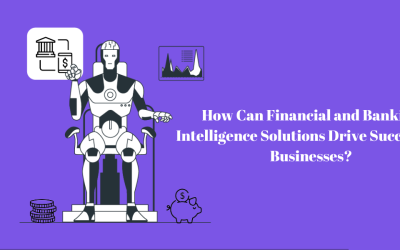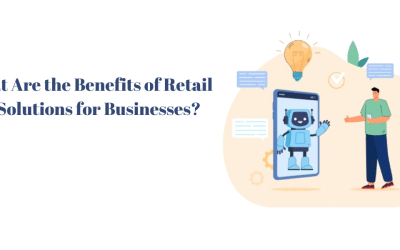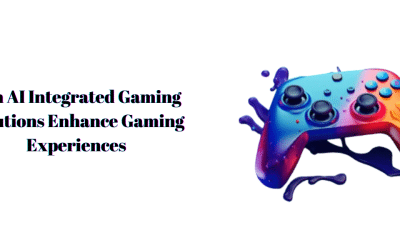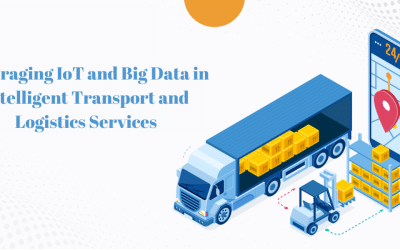As we move into the future, technology changes how we manage our financial affairs. The transformation is the beginning of smart banking tools, a new revolution within the field of finance. It incorporates the latest technology and banks to streamline and increase customer satisfaction. Through the years, the banking industry has evolved from manual transactions and brick-and-mortar establishments to online platforms. The latest innovations in AI Finance And Banking Solution Development aren’t solely disruptive but are also essential and set new standards regarding security, efficiency, and customer interaction. In banking, the king is like a personal finance expert in your pocket. They provide the same experience as a financial expert inside your wallet.
Everything from AI or augmented reality to chatbots and IoT cutting-edge technologies are changing how consumers and financial institutions experience and use banking services. The latest digital advancements can allow you to make payments, control your finances, and maintain your health. The era of smart banking will bring not only ease of use but also an entirely new degree of personal financial advice and safety. It requires constant monitoring to ensure that these tools remain focused on customers’ needs.
The Rising Popularity Of Smart Banking
There are no longer days when banking meant long lines, heavy papers, and a standard-fits-all method. The future of banking is smart banking, which uses cutting-edge technology to provide individual, efficient, and secure financial services.
Imagine opening your bank application and being greeted by a virtual agent who knows your spending habits, offers investment advice in real-time, and can even detect suspicious activity in your account. Consider using augmented reality to show your finances and break down the data into digestible and interactive information. These aren’t futuristic ideas; instead, they are existing solutions from forward-thinking banks. In essence, smart banking refers to the incorporation of cutting-edge technology in financial services that facilitate personal, secure, and efficient operations and the administration of assets in the financial sector.
The Foundations Of Smart Banking
Smart banking combines traditional and cutting-edge digital technology for an effortless, personal, and effective banking experience. The fundamental principles behind AI Finance And Banking Solution Development Company center around access, automation, personalization, security, and accessibility. This allows customers to control their money at any time, from anywhere, with personalized guidance and the highest level of security. The key to smart banking is the technological innovations that have led to the transformation.
Artificial Intelligence (AI)
AI is a crucial element for AI, from chatbots offering quick customer service to algorithms that provide personalized financial advice depending on income, spending habits, and budget objectives.
Internet Of Things (IoT)
IoT-connected devices, such as smartwatches and smart home devices, make banking much more easily accessible than it ever was. Thanks to IoT banking, transactions can be completed with only a couple of voice commands or a tap on the wrist.
Blockchain
The technology provides a whole new degree of transparency and security to banking. Through blockchain, transactions become uncentralized, secure, and irrevocable, providing unmatched protection from fraud.
Data Analytics
Data analytics can help banks better analyze customer behavior, forecast trends, and deliver customized services. This aids in fraud prevention, risk assessment, and constructing a customized financial product.
They work together and shape the direction of intelligent banking. They will set the tone for an experience with banking in 2024 that’s more intelligent, fluid, and supportive of customers.
Key Features Of Smart Banking In 2024
When we look deeper into the possibilities of smart banking by 2024, we can see that the next generation of banks will be focused on personalized customer experience. That offers seamless transactions made through technology, robust security measures, and the integration of virtual assistants and chatbots. Each one of these features provides distinct benefits that help make banking more effective, secure, and user-friendly. This will ensure that clients can easily control their funds and have trust. Let’s look at these four essential aspects of smart banking in depth.
Personalized Customer Experiences
Personalized customer experiences are the foundation of smart banking. They are created to cater to each customer’s individual requirements and preferences, resulting in a completely individual experience. However, personalized service goes far beyond advice and recommendations. It uses the information to analyze customer behavior, automate the financial process, and create products tailored to customers’ needs.
- Artificial Intelligence (AI) enables banks to offer personalized services by analyzing customers’ behavior and habits in the financial market. These can include financial counseling, customized promotion of financial products, and budget predictions based on consumer consumption habits.
- Predictive analytics employ data, statistical algorithms, and machine-learning techniques to predict future scenarios by analyzing previous information. In smart banking, technology can assist in predicting a client’s future behavior in the financial sector, enabling banks to offer proactive guidance or other services.
Seamless Digital Transactions
Smart banking can eliminate the need to use physical transaction methods, making banking an entirely digital experience. It makes payments more manageable, simplifies processes, and allows customers to use financial services easily in their homes and on the go.
- Smart banking uses mobile technology, allowing customers to make bank transactions from anywhere around the globe, providing features like money transfers, bill payments, and accounts management directly on a mobile device.
- Contactless payment options allow users to pay directly on their smartphones without needing physical cards, making payments faster and easier.
- Digital wallets are a secure option for consumers to digitally store data about their cards, making online transactions effortless and safe.
Enhanced Security Measures
With the popularity of electronic transactions comes the requirement for a robust security system to safeguard against fraud and cyber-attacks. This new approach to security is the main characteristic of smart banking, offering customers peace of mind about their financial security.
- Biometric authentication utilizes distinctive biological features, including fingerprints and facial recognition, to prove an individual’s identity and provide additional security.
- Blockchain technology creates an unencrypted and decentralized ledger that records transactions, making transactions secure and transparent and protecting against fraud.
Integration Of Chatbots And Virtual Assistants
Smart banking uses chatbots powered by AI and virtual assistants for quick customer support and personalized guidance. Digital assistants can answer the most basic questions, give suggestions on financial matters, and automate bill payments.
- Chatbots can handle various customer queries at all hours, offering instant response times and allowing staff members to attend to complicated issues.
- Virtual assistants can provide personalized financial recommendations based on a person’s financial habits and objectives to help them make better financial decisions.
Smart Banking Tools And Technology 2024
Customers’ expectations are constantly changing and are influenced by the experiences of other industries. Such as in healthcare and retail, in which personalization and ease of use are the norm, not exceptions. The use of smart banking technology is the central point in meeting new expectations.
Some technologies are notable for their capability to transform the banking experience. These innovations aren’t only innovative but also foundational in establishing new standards in efficacy, security, and customer interaction.
Artificial Intelligence
Artificial Intelligence (AI) within banking provides superior customer service and reduces operational expenses. Utilizing AI-powered instruments like virtual assistants or chatbots, banks can automate customer service processes, efficiently resolve account-related questions, and offer quick access to account details. Integrating biometrics based on Financial And Banking Intelligence Solutions increases security measures by detecting fraudulent activity, improving Anti-Money Laundering (AML) applications, and facilitating Knowing Your Customer (KYC) checks.
Machine-learning (ML) algorithms significantly transform credit scoring models, allowing banks to make more educated lending decisions. Computer vision-powered tools simplify document analysis, facilitating smooth customer onboarding and bank compliance management. Beyond this, AI analyzes extensive financial data sets, assisting in better risk analysis, forecasting financials, and ultimately improving investment decision-making.
Blockchain Banking
Blockchain banking enables the establishment of tamperproof records of all transactions in financial institutions, which improves security and transparency in the procedure. Blockchain banking goes beyond automating transactions, thus improving trade efficiency and eliminating errors associated with manual and paper-based processes. The implementation of smart contracts will further transform financial transactions, making processes more efficient and improving the efficiency of economic agreements.
Augmented Reality
Augmented Reality (AR) has surpassed the limits of being restricted to entertainment and gaming; it’s expanding its reach into the banking industry, providing the most interactive and enhanced customer experience. Customers will benefit from AR because it will change how they use their personal financial information.
Smart Know Your Customer (KYC) solutions
In a period of fraud and data breaches that occur frequently, Know-Your-Customer (KYC) solutions are becoming essential for the banking industry. KYC solutions are primarily used to improve customer security and ensure regulation compliance. Financial institutions are utilizing sophisticated KYC platforms that utilize biometric verification and document authentication to speed up the onboarding process. This reduces the time spent on the administrative process and the chance of fraud.
KYC services are changing to incorporate machine-learning algorithms that constantly update customers’ risk profiles. Identity verification firms have created tools to analyze various data elements, including transaction histories and online activity, helping banks adjust their risk profiles in real-time. Smart contracts play an essential role in eliminating intermediaries by facilitating seamless peer-to-peer (P2P) transactions. This technology significantly improves the speed of transactions and their efficiency, specifically in the field of cross-border payments. In addition, blockchain’s integration with the decentralized financial system (DeFi) helps to make financial services more accessible and available to more people.
Instructional And interactive manuals
Rich media and educational content is an effective strategy for meeting customers’ expectations. Studies show that this content resonates well with consumers. 76% want a guide to buying tailored to previous purchases and other activities, 81% want a customized video tour, and 83% want videos explaining their latest purchase. This is a way of providing bank customers with personalized video tutorials for increasing their credit score, giving new cardholders an overview of what they can expect from their first statement, and providing an online buying guide for new homeowners seeking mortgage loans.
The information is tailored to the maturity of their finances. These efforts increase the customer experience and align with changing preferences for personalized and helpful interactions with financial services.
Mobile Banking
Most banks have been slowly making it easier for their customers to create accounts, deposit checks, transfer money, and apply for loans, all through the comfort of their mobile phones. This accessibility level enhances the user experience and lowers the cost of operations associated with branch services.
Mobile banking has gone from a simple option to conventional banking and is now becoming the mainstay of consumers’ bank experience. Features like instant payments, budgeting tools, and secured payments have transformed how consumers manage their money. Several banks are allowing their customers to create accounts, deposit checks, transfer money, and request loans through the comfort of their phones.
Automation Of Processes By Robotics (RPA)
Automated process automation (RPA) is a revolutionary technology that automates routine task-based processes, freeing people to focus on more strategic and customer-centric tasks. RPA is frequently regarded as a type of AI For Financial And Banking Software. However, it’s worth mentioning separately due to its particular application in banking.
In contrast to general AI developed for many different activities and decisions, RPA excels at executing specific, repetitive tasks with the highest level of quality. RPA has been remarkably efficient in streamlining the back-office processes within the banking industry. RPA integrates seamlessly with various other intelligent banking technologies, including AI.
Chatbots, As Well As Virtual Assistants
Virtual assistants and chatbots are now commonplace in innovative banking, acting as the primary stage of customer support. In contrast to traditional channels for customer support, they provide 24/7 support, drastically decreasing customer wait times. The virtual assistants on these platforms are not limited to essential tasks. They can tackle complex issues and provide personalized financial assistance. Like Cleo, an AI-powered financial assistant studies spending patterns and provides individualized financial advice and budgeting strategies.
Chatbots and virtual assistants offer value beyond customer convenience. Banks can gather valuable customer behavior data to improve their products and services and provide more tailored experiences for their clients.
Solutions For Cybersecurity
Smart banking solutions for cybersecurity include more than security software and firewalls. They employ advanced technologies, including machine learning and behavioral analytics, to identify and reduce risks. The solutions detect suspicious activity on a bank’s network, providing real-time alerts to possible security breaches.
The tools used to protect your cyberspace play a crucial function in protecting sensitive personal information and keeping up with changing regulations. They can also protect you from various dangers, ranging from phishing-related attacks to more advanced persistent security threats. In addition, measures to protect against cybersecurity boost customer trust, which is a crucial element in the finance sector. People are more likely to use banking services that they feel are safe.
Open Banking APIs
APIs for banking open (application programming interfaces) are the connective layer of the smart banking ecosystem, allowing seamless interoperability between different financial services and platforms. They offer a standard way for fintech companies, banks, and other third-party companies to share their data securely to encourage creativity and competitiveness within the sector.
Furthermore, APIs that allow banking to be open assist in ensuring compliance with regulatory requirements by ensuring data sharing is by strict security requirements. Additionally, they allow banks to discover new revenue streams by providing API-based services to other entities.
Internet Of Things (IoT)
The Internet of Things, or IoT, has expanded the reach of banking through smart technology beyond traditional platforms. It brings more connectivity and information-driven insight for consumers and banks. IoT-enabled gadgets, such as smart ATMs and wearables, offer real-time updates on transactions and account alerts. This will significantly improve customer comfort and efficiency in operations.
Challenges And Risks In Smart Banking
Awareness of the risks and challenges associated with using smart banking is crucial. Despite the apparent benefits of smart banking, it also poses issues related to privacy and security, regulatory issues, and technology risks.
Security Concerns
Today, examination and security remain the primary issues. Data breaches, cyber threats, and attempts to commit fraud have become more sophisticated and require the most up-to-date security strategies to mitigate them. Although blockchain technology and encryption techniques improve security, constant surveillance and upgrades are essential to keep pace with the ever-changing security threats.
Privacy Issues
Banks are responsible for protecting their customers’ privacy when managing considerable personal information. Data breaches could cause severe financial damage and damage to customers’ confidence. So, banks must invest in solid data security methods and adhere to international privacy rules for data, like the GDPR.
Regulatory Challenges
The rapid development of technology-driven banking tends to outpace regulatory frameworks, which can lead to issues with compliance. With new technology and methods introduced, regulators must keep up with the pace, and banks could find it hard to ensure their activities adhere to the changing regulations. Collaboration among tech companies, banks, and regulators is required to create comprehensive and adaptable rules.
Technological Risks
Smart banking is heavily dependent on technology, so technology-related failures could have devastating consequences. Risks associated with system downtime, software glitches, and errors in AI algorithms can disrupt bank operations and ultimately affect the customer’s confidence. Banks must build robust and reliable technology to reduce the risks and conduct periodic system check-ups and upgrades.
Future Outlook Of Smart Banking
As we move toward an era of change, the world of smart banking continues to develop. Innovations and new technologies have shaped the banking landscape, challenging the traditional model and influencing the regulatory framework. In this section, we will examine the changes in depth and explain what they mean for the future of banking technology in 2024 and beyond.
- New technologies such as Artificial Intelligence (AI), Machine Learning (ML), the Internet of Things (IoT), and 5G are expected to change how we pay. AI and ML improve the banking experience by enhancing personalization and helping detect fraud, while IoT allows seamless integration with banks. Furthermore, the arrival of 5G technology is expected to improve the speed of transactions and the user experience on mobile banking.
- The future of intelligent banking has many possibilities for innovation. This could be the case with voice-activated banking assistants, biometric security, and incorporating banking services with wearable technologies. Moreover, AR and VR could change how customers engage with their banks by offering virtual banking experiences that resemble offline experiences.
- The rapid growth of smart banking is an enormous problem for traditional banking. The ease, speed, and personalized services the smart banking model offers draw consumers away from traditional brick-and-mortar institutions. To remain competitive, traditional banks must invest in cutting-edge technologies and offer new customer-oriented services.
- With the development of smart banking, the regulatory frameworks will undergo significant adjustments. Regulators are expected to issue new regulations to ensure the security and integrity of using new technologies in banking. Additionally, we should expect more robust safeguards for personal data and stricter rules to protect our customers’ rights.
Final Thought
Financial institutions can harness the benefits of using the open bank, immersive technology, and artificial intelligence, and focusing on personal interactions will become a major priority. Additionally, collaboration with companies that develop mobile apps and the decision-making process to employ dedicated developers are crucial in determining the direction of intelligent banking.
From AI-driven personalized services to IoT-powered real-time updates, these devices have set new standards in efficacy, security, and customer engagement. What does this mean to you, the customer, or financial institutions trying to stay on top of their game? The benefits for consumers can be numerous. Imagine a future in which your bank knows your spending habits, gives you real-time information regarding investment options, and gets an overview of your portfolio using virtual reality.
For banks, the stakes are just as high. Adopting these tools is about more than just keeping pace with the competition. It’s about creating new standards in the banking industry and changing the essence of banking. Institutions that aren’t able to change could be deemed obsolete and surpassed by faster and more technologically proficient counterparts. Furthermore, these tools can bring efficiency to operations and new revenue streams ranging from API-based services to personalized, data-driven offerings.
One thing is evident in the future: the distinction between banking and technology is blurring and rushing. There is no question of how banks will take on the new technologies, but more about how quickly they can incorporate them to provide a smooth and personal experience. Consumers should not only be thrilled but remain vigilant to ensure that when our banks get better at their jobs, they are also safe and focused on our requirements.











